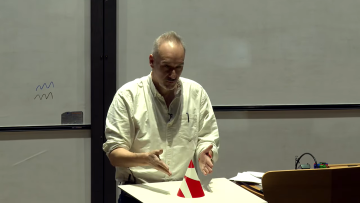Genus-one data and anomaly detection
Yu, M
Physical Review D
volume 105
issue 10
106007
(15 May 2022)
Background field method for nonlinear sigma models in nonrelativistic string theory
Yan, Z
Yu, M
Journal of High Energy Physics
volume 2020
issue 3
181
(30 Mar 2020)
Counting graphic sequences via integrated random walks
Balister, P
Donderwinkel, S
Groenland, C
Johnston, T
Scott, A
Transactions of the American Mathematical Society
(03 Apr 2025)
Happy New Year. And as it's a new year, as usual we have lots of student lectures which you can watch for free. We have already started with Andy Wathen introducing Complex Numbers to our first years and Alain Goriely, complete with 3D print out (picture) explaining the geometry and eavesdropping potential of Conics to the same group.
On the regularity problems of Einstein equations
Wang, Q
Comptes Rendus - Mecanique
The structure and density of k$k$‐product‐free sets in the free semigroup and group
Illingworth, F
Michel, L
Scott, A
Journal of the London Mathematical Society
volume 111
issue 1
(14 Dec 2024)
Nonlinear soft mode action for the large-$p$ SYK model
Bucca, M
Mezei, M
(19 Dec 2024)
http://arxiv.org/abs/2412.14799v1
On Ruzsa’s discrete Brunn-Minkowski conjecture
van Hintum, P
Keevash, P
Tiba, M
Proceedings of the American Mathematical Society
(12 Dec 2024)
On the Length of Directed Paths in Digraphs
Cheng, Y
Keevash, P
SIAM Journal on Discrete Mathematics
volume 38
issue 4
3134-3139
(31 Dec 2024)
Multiscale modelling shows how cell-ECM interactions impact ECM fibre alignment and cell detachment
Arellano-Tintó, J
Stepanova, D
Byrne, H
Maini, P
Alarcón, T


